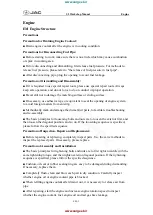
Driving
●
If the brake warning lamp lights up
to-
gether with the ABS lamp
this could be
due to an ABS fault. When this function
fails, the rear wheels can lock up. Under
certain circumstances, the rear of the vehi-
cle may skid, with the danger of losing con-
trol. Stop and seek technical assistance.
●
If the lamp
lights up, alone or accom-
panied by a warning message on the in-
strument panel display, please go immedi-
ately to a specialised workshop to check
the brake pads and to replace them if they
are worn.
Information about the brakes
New brake pads
For the first 200 to 300 km (100 to 200
miles), new brake pads have not yet reached
their maximum braking capacity, and need to
be “run in” first. However, you can compen-
sate for the slightly reduced braking effect by
applying more pressure on the brake pedal.
Avoid overloading the brakes while running
them in.
Wear
The rate of wear on the
brake pads
depends
a great deal on how you drive and the condi-
tions in which the vehicle is operated. This is a
particular problem in urban traffic and short
stretches, or with very sporty driving.
Depending on the speed, the braking force
and the environmental conditions (e.g. tem-
perature, air humidity, etc.) noises may be
produced when braking.
Wet roads or road salt
In certain situations (for example, on driving
through flooded areas, in severe downpours
or after washing the vehicle) the braking ac-
tion could be delayed if the discs and pads
are damp, or frozen in winter. In this case the
brakes should be “dried” by pressing the
brake pedal several times.
At high speed and with the windscreen wipers
activated, the brake pads will briefly touch
the brake discs. This takes place, although
unnoticeable to the driver, at regular intervals
to improve the response time of the brakes
when they are wet.
The effectiveness of the brakes can also be
temporarily reduced if the vehicle is driven for
some distance without using the brakes when
there is a lot of salt on the road in winter. The
layer of salt that accumulates on the discs
and pads can be removed by gently apply-
ing the brakes a few times.
Corrosion
There may be a tendency for corrosion to
form on the discs and dirt to build up on the
brake pads if the vehicle is used infrequently
or the brakes are not used very often.
If the brakes are not used frequently, or if rust
has formed on the disks, it is advisable to
clean off the pads and disks by braking firmly
a few times at a moderately high speed
.
Fault in the brake system
If the brake pedal travel should ever increase
suddenly
, this may mean that one of the two
brake circuits has failed. Drive immediately to
the nearest specialised workshop and have
the fault repaired. Drive there slowly and re-
member that you will have to apply more
pressure on the brake pedal and allow for
longer stopping distances.
Low brake fluid level
Malfunctions can occur in the brake system if
the brake fluid level is too low. The brake fluid
level is monitored electronically.
Brake servo
The brake servo increases the pressure you
apply to the brake pedal. It works only when
the engine is running.
WARNING
Any anomaly in the brake system can in-
crease the braking distance, with the re-
sulting risk of an accident.
●
New brake pads and discs must be run in
and do not have the correct friction during
the first 200 km (124 miles). This reduced
264
Содержание Ateca 2020
Страница 1: ...Ateca Owner s manual 575012720BP Ingl s 575012720BP 07 20 SEAT Ateca Ingl s 07 20...
Страница 6: ......
Страница 70: ...Operation Fig 66 Instruments and controls 68...
Страница 357: ...Indications about the technical data Dimensions Fig 235 Dimensions 355...
Страница 374: ......
Страница 376: ...Ateca Owner s manual 575012720BP Ingl s 575012720BP 07 20 SEAT Ateca Ingl s 07 20...
















































